Jerilyn Lopez Mendoza is policy director for the Los Angeles Environmental Justice Project Office of Environmental Defense. Her work focuses on greening the built environment, increasing green space in L.A.’s urban core, and ensuring transportation equity for the working poor.

Monday, 5 May 2003
LOS ANGELES, Calif.
Monday mornings are rough, especially when you’re trying to be healthy and kick caffeine. Truly awake or not, my first task is to check my calendar. On the Los Angeles environmental front, that means lots of meetings to coordinate campaigns and share information with local partners or my Environmental Defense colleagues.
Yes, you read that right. I’m an environmentalist in Los Angeles. In spite of L.A.’s reputation as a vast wasteland, there are a lot of us “enviros” in the City of Angels. We work on a variety of issues, from protecting wetlands near the Pacific Ocean to fighting freeway expansion in low-income, minority neighborhoods. Neighborhood groups work side-by-side with health clinics, environmental attorneys, and organizers to create a healthy, more livable environment — a demanding challenge with many rewards.
I work for a national environmental advocacy group that has over 300,000 members. Environmental Defense is a nonprofit dedicated to protecting the environmental rights of all people, including future generations. We work to link science, economics, law, and innovative private-sector partnerships to create breakthrough solutions to the most serious environmental problems.
I’m the policy director in the Los Angeles Environmental Justice (L.A. EJ) Project Office. The L.A. EJ project is part of our new Living Cities program, which aims to solve the most critical urban environmental problems. Here in Los Angeles that means giving marginalized residents a voice in the decisions that affect their lives, such as land use and environmental policies. Using the resources of Environmental Defense and applying environmental justice principles, we work with diverse community organizations and residents to achieve the goals that we set together.
L.A. EJ is presently working on a number of projects to bring positive land-use change to our fair city. One involves creating a land trust to develop vacant lots into an oasis of community space. Another organized a broad coalition to encourage equitable smart growth principles in local land-use decision-making. You’ll probably hear more about those efforts later this week.
But today, I’m focused on a national Environmental Defense effort that resonates with all L.A. residents — smog. I’ve got a conference call today with several Environmental Defense colleagues to strategize on how to reduce diesel pollution, a major contributor to smog.
When residents of L.A. or other major cities are warned about high ozone or smog levels, they naturally assume cars, trucks, and buses are the culprits. But what about the pollution from other large engines such as those in lawn tractors, construction equipment, or household power generators? This class of non-road diesel vehicles and their pollutants contribute to a host of public health and environmental hazards including cancer risk, premature death, respiratory ailments, asthma attacks, smog, acid deposition, and haze.
Environmental Defense recently published a report, Closing the Diesel Divide, that articulates the risks of non-road diesel emissions and offers solutions to reduce the public health and environmental threat. At the same time our report was hitting the streets, the U.S. EPA proposed a rule to regulate non-road diesel emissions nationwide. The proposed rule was very positive and would be equivalent to removing 90 percent of all cars from the roads.
In June, the EPA is holding hearings across the country to compile public comments on the proposed rule. Environmental Defense is rallying troops to attend those hearings and give input. We are encouraging the EPA to move forward with this necessary regulation. Strong policies like this one spur the transition to cleaner engines and a healthier environment.
So what’s my role in this national effort? I’ll be helping to coordinate and encourage Angelenos to testify at the EPA hearing here in L.A. on June 17. I’ll also work to reach out to Spanish-speaking communities about our diesel report and the upcoming hearing. In light of our diverse and growing population in Los Angeles, Environmental Defense makes a point to translate relevant materials into multiple languages.
Because air quality is such a huge issue here, we’ve translated our diesel report into Spanish as a first step to sharing the information with Spanish-speaking populations and encouraging their participation in the issue. According to recent government and academic studies, there are strong correlations between diesel emissions and cancer rates and asthma in the L.A. basin, especially among children and the elderly. Anything we can do to improve air quality and decrease toxic emissions helps us all.
A final check of my calendar tells me it’s Cinco de Mayo, a cultural celebration for Mexicans and Mexican-Americans. On this holiday I’m reminded of the importance of livable communities that guarantee healthy air and open space so that extended families can gather to visit, picnic, and play. Being an environmentalist in Los Angeles certainly has its challenges, but the rewards are far greater!
Tuesday, 6 May 2003
LOS ANGELES, Calif.
Another Monday safely over, and Tuesday looms large. This morning, my colleague, Luis Flores de Luna, and I will spend some time getting ready for a Los Angeles Neighborhood Land Trust meeting this afternoon. Our office is small — right now, it’s just the two of us! — so we tend to work together pretty closely.
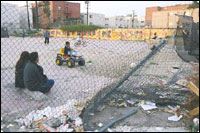
Low-income families often have little choice but to use abandoned spaces — like this one — to rest, relax, and watch their kids play.
What, you may ask, is LANLT? Good question. The answer requires some historical context. One of the challenges of working in the urban environment is helping folks understand our priorities. Our landscape is different from, say, wilderness areas, where ecosystem preservation and protection of endangered species are paramount. In Los Angeles, access to open space — places like community gardens and parks, where we can sit under a tree, watch our children play, and help things grow — is a huge urban environmental issue. Whenever Luis or I attend meetings in L.A., whether on land use, planning new schools, or city elections, the lack of open space and parks always comes up.
Like New York City and San Francisco, we have some great large spaces (such as Griffith and Elysian parks) that green our landscape. However, of all major cities in the United States, Los Angeles ranks last in per capita open space. Although national standards call for 10 acres of neighborhood parks per 1,000 residents, Los Angeles barely reaches 10 percent of that standard, with 1.1 acres per 1,000 residents.
In lower-income areas of the city, green space is even harder to come by. Driving to our office in Koreatown in the Central City area, or walking to the subway (yes! Los Angeles has a subway!), I see too many abandoned, vacant lots, just sitting there, contributing nothing to the community but blight. The five poorest City Council districts have just 17 percent of total neighborhood park space — an average of 0.45 acres of park space per 1,000 residents. If you are low-income and have limited access to cars, it’s not always easy to get to the larger parks or beaches. People want to be able to walk to a park, to take their kids there in strollers. They don’t want to have to take two different buses that might take an hour or two just to get somewhere peaceful.
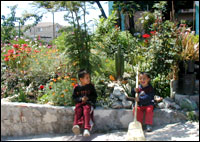
The Francis Avenue Community Garden is the kind of space we want to see more of in Los Angeles. The land trust will get us there!
Happily, a lot of attention has been devoted to this issue in Los Angeles and in California more generally over the past few years. In 2000, we passed a statewide bond that allocated several million dollars to park and open-space development all over the state, with an emphasis on urban areas. That success was replicated last year, when L.A. passed a similar bond. It’s exciting to hear about the various projects that will result from these funds. However, as these bond measures progressed, many park advocates in Los Angeles worried that the funds wouldn’t reach the neglected, lower-income neighborhoods that need them the most. During the development of burdensome state funding guidelines, it became clear that smaller community and neighborhood groups just didn’t have the resources and capacity to apply for those funds, in spite of their best efforts and tons of interest.
In 2001, after watching the frustration grow, we started meeting with several other nonprofit groups concerned with open-space development to revitalize a group called the Verde (Green) Coalition. Our goal was to “work to identify and implement the most effective and fair ways to ensure that all residents of Los Angeles live within a one-quarter mile walking distance of a community park, garden, or playground.” The group had been created by Coalition L.A. and the California League of Conservation Voters Education Fund a few years before, to work on the same issue. But with the passing of the statewide bond, the Verde Coalition, with its focus on smaller open spaces and lower-income neighborhoods, saw a unique opportunity to create positive change.
But how? Trying to affect spending of the bond funds on the state level had proved difficult and unrewarding, so we focused on local strategies. After a lot of research about what worked in other major cities (e.g., Chicago, Baltimore, and Boston), the Verde Coalition decided to support the idea of a land trust. A private, nonprofit land trust could act as both technical advisor to community groups interested in developing open space in their neighborhoods, and land owner if those groups couldn’t own land themselves. In this way, smaller vacant properties that are unsuitable for new housing or schools could be revitalized, with the trust acting as a land-use and community-development tool.
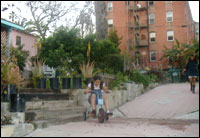
Transforming vacant land provides our kids with safe places to play.
This idea had been explored years before with some help from the City Council, but didn’t really go anywhere. This time, working with Los Angeles City Council members Eric Garcetti, City Miscikowski, and Ed Reyes, as well as Los Angeles City Mayor James Hahn and Los Angeles Attorney Rocky Delgadillo, the Verde Coalition helped convene a city-wide task force to study how best to create a Los Angeles land trust. The 26-member group represented public and private interests, Verde Coalition members, representatives from several city departments, developers, and economic development specialists. Environmental Defense’s role helped convene the task force, coordinate the Executive Committee of the task force, and draft the final task force report, “Walking to the Park.”
Since the task force unanimously recommended that the land trust be organized as a separate nonprofit organization, the Verde Coalition helped convene a board-selection committee last fall to choose a board of directors for the new organization. A diverse group of leaders worked over several months to find board members dedicated to the idea of urban open spaces. At the same time, I began the process of legally creating a new corporation for LANLT. (Yup, I’m a lawyer. Please don’t hold that against me!)
The trust is coming together. The new board was finalized in February and has already met several times to plan the future of LANLT. The new board members are amazing. Luis and I are meeting with them individually, and they are truly visionary leaders with lots of energy. Luis currently coordinates the still-vibrant Verde Coalition and the new LANLT until it can raise enough funds to get its own staff. Granted, with the economy being so bad right now, it’s a pretty difficult time to raise funds for a brand-new organization. However, the need in Los Angeles is urgent, and even with our most ambitious timeline, it will take months to get LANLT working. In the meantime, we’re still holding onto that simple goal that everyone in L.A. should be able to walk to a neighborhood park.
Wednesday, 7 May 2003
LOS ANGELES, Calif.
It’s late afternoon and I’m in a classroom on the second floor of a Catholic school in the Adams-La Brea neighborhood of Los Angeles with several other people, discussing the importance of resident involvement in the May 10 run-off election for City Council District 10. We’re figuring out the format, questions, and a Spanish/Korean/English translation plan for a “meet the candidate event” we are planning for next week.
How is this tied to environmental quality in Los Angeles?
As you know, there are no easy answers to environmental problems. Most require education, creativity, tenacity, and negotiation. In the urban environment, many issues come down to basic land-use decisions, whether you’re struggling with historically bad decisions (such as zoning an area for industrial uses across the street from homes and schools) or positively influencing new decisions about where to locate freeways, housing developments, parks, libraries, light rail, schools, health clinics, and economic development projects.
I’ve had some experience trying to affect transportation decisions — no small matter in car-crazy Los Angeles. Back in 2000 and 2001, both our county and regional governments were engaged in long-term transportation-planning processes. I went to all kinds of meetings, workshops, and events to try to raise transportation issues relating to people who don’t own cars — people who are often not invited to these planning meetings, don’t know about them, or can’t participate because they are at work when the meetings take place.
I worked to encourage transportation planners to fully consider the impacts of their long-range plans on poor people who ride the buses and transit lines for hours a day to get to and from work, school, doctor appointments, and other obligations. Working with others with similar concerns, we drafted letters, made phone calls, and attended meetings, meetings, and more meetings with transportation officials, academics, consultants, and anyone else who would listen. Some of our concerns were reflected in the final planning documents, but it was exhausting and I often felt like I was banging my head against a wall. Not fun.
Once that terribly frustrating experience was over, I started talking to people. I floated the idea of developing an alternative transportation plan — something that would incorporate cleaner transportation options such as more clean-fuel buses and light rail, rather than building more highways and freeways for cars and trucks to further pollute our already dirty air. Early last year, I met with Beth Steckler, a member of the Verde Coalition (see yesterday’s entry), a long-time affordable housing advocate, and policy director of Livable Places, a nonprofit housing developer. We talked for a couple of hours about my idea and about Beth’s concern with the housing crisis in Los Angeles — how low- and even middle-income residents are forced to live in over-priced and substandard housing because there just isn’t enough decent, affordable housing to keep up with population growth. At that point, Beth brought up an intriguing question: Why not look at the big picture — not just transportation but land use as it relates to housing, parks, and transportation?
The more I thought about it, the more it made sense to me. And the timing is right. Several state bonds have been passed in the last couple of years that give localities money for new parks, schools, and housing, but there’s no master plan for creating land-use projects that are green and efficient, incorporating the best elements of smart-growth thinking and urban design. These kinds of big-picture issues affect all of us in Los Angeles.
I found a great quote from Albert Einstein, which we agreed would be our guiding motto: “The significant problems we face cannot be solved by the same level of thinking that created them.” With that in mind, last May, Beth and I convened a meeting of people we thought might be like-minded to discuss what we could do as a group to raise awareness about smart and fair land-use decision-making. We contacted regional and state “smart growth” groups, unions, other environmental groups, economic-justice institutions, housing advocates, and faith-based organizations. Essentially, we just wanted to know if others might be interested.
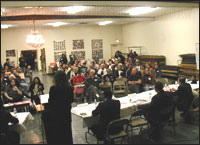
The candidate forum on livability.
Guess what? They were. We didn’t have enough food or chairs for all the folks who showed up to talk about land use. Even if transportation or housing or parks wasn’t “their” issue, everyone agreed that such decisions affect all of our livability choices — where we live, where we play, how we get to work and back — and everyone cared enough to want to learn more. And thus an equitable smart-growth Los Angeles coalition was born.
In the year since our first meeting (and after a lot of discussions and emails), we have a name for our group, “Alliance for a Livable Los Angeles,” and a mission statement: “Make L.A. more livable for everyone, including low-income people, by creating more affordable housing, transportation options, and neighborhood open space.” We have values, goals, and objectives that have kept the alliance strong and vibrant. A constant influx of new members reassures us that we’re making progress.
The alliance’s first big effort was to launch an education effort targeting candidates in last month’s run-off elections for the Los Angeles City Council. We compiled information and action steps on housing, transportation, and parks into one large document and created a “Candidate Briefing Paper,” including recommendations for action on the issues we cared about. (Click here to download a copy of the paper.) We also sponsored a candidate forum for the six candidates running in the 10th City Council District, which was electing a new council member for the first time in decades.

After the forum, organizers Lopez Mendoza, Lizette Hernandez, and Beth Steckler pause for a sigh of relief.
The forum was co-sponsored by five other organizations (including two neighborhood groups) and held at St. Agatha Church’s parish hall. We provided simultaneous translation in Korean and Spanish as well as child care, and we asked targeted questions about livability, public safety, housing, and park development. Due to the hard work of all involved, we had a standing-room-only crowd and were complimented by several of the candidates for providing a well-organized and diverse setting for the forum. Our first big effort was a success! And we were so thrilled, we’re moving forward with a second “meet the candidate” event with the two remaining candidates.
We know we have an ambitious agenda — educating local planning commissions about the benefits of smart-growth planning, pushing the idea of joint-use agreements for school and park spaces, supporting affordable housing projects, especially those near transit stops. But we’re determined to move forward together, even with our many different work priorities, to create a greener and more just Los Angeles.
Thursday, 8 May 2003
LOS ANGELES, Calif.
I’m on a plane, on my way to the board meeting in New York City, where Environmental Defense was founded. I’m looking forward to seeing my colleagues and board members, but too much travel can wear me out. I hope this trip is a healthy one.
One of the committee meetings (and there are many) that I’m looking forward to attending is the environmental justice meeting. The committee has been very supportive of our work in Los Angeles. They’ve expressed particular interest in a “community benefits package” that I helped broker two years ago and is now in the implementation stage. Let me explain the concept.
Economic-development projects in dense urban areas have the potential to bring both benefits and burdens to the neighborhoods. For example, a new grocery store could provide a needed retail service, as well as possible job opportunities for local residents. Conversely, the negative effects of a new store include exposure to diesel emissions from equipment during the construction or renovation stage. Traffic could increase as well, further burdening local health. In this way, economic-development projects can be a blessing and a curse, even in low-income or blighted areas in need of investment.
Another complicating factor is the prevalence of public funds that subsidize economic development. Federal, state, and local entities often provide support in the form of grants or loans based on redevelopment or other urban development priorities. In some cases, millions of public dollars are allocated to developers for construction of their projects. However, its often difficult to see how the public benefits from the expenditure of such funds.
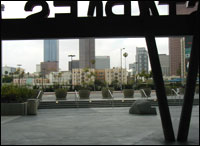
Low-income housing just across the street from the Staples Center.
Many of you are familiar with the Staples Center Arena in downtown Los Angeles. In addition to concerts and other one-time events, the Staples Center is the home to several sports teams, including the Los Angeles Lakers, Clippers, Sparks, and Kings. It is one of the largest inner-city developments in an urban neighborhood anywhere in the U.S.
In the spring of 2000, Staples announced its plan to create a “Sports and Entertainment District” in the Central City area of Los Angeles, including the introduction of three million square feet of development over the next several years. The blueprint includes two hotels, a theater with 5,000 to 7,000 seats, 500 to 800 units of market-rate housing, and various retail and commercial spaces, including, possibly, high-end office space. Staples also requested significant public subsidies to support the development of one of the hotels.
However, many residents in the surrounding neighborhood (almost all of whom are very low-income and people of color) were already seriously concerned about the negative impacts of the initial Staples Center project, which forced the relocation of 200 low-income families to create parking, increased traffic, vandalism, and public drunkenness, and reduced parking and pedestrian safety. When the expansion was announced, the local residents were concerned that they would see few of the benefits and more of the social costs.
After several months of talking to each other about the project, residents and community leaders, including Environmental Defense, came together through the Figueroa Corridor Coalition for Economic Justice. Together, they approached the developer and asked for the opportunity to present their concerns. Worried about opposition to the project and aware of problems with the development of the Staples Center Arena in the late 1990s, the developer was open to the discussion.
Meetings were held to discuss the concerns of local residents and develop possible solutions. At the same time, Environmental Defense worked with other coalition members to formally document comments on the developer’s draft Environmental Impact Report for the expansion. The developer reviewed the coalition’s comments and recognized that it was more advantageous to work together. Thus began a four-month negotiation process between the developer and the coalition, which resulted in a comprehensive, legally binding community-benefits agreement.
The final community benefits agreement states that the developer will provide:
- $1 million for development of park or green space within a one-mile radius of Staples Center
- $75,000 for a park needs-assessment of the local community
- a customized job training and first-source hiring program targeting local residents
- affordable housing, developed in collaboration with nonprofit housing developers and accounting for at least 20 percent of all housing developed from the site; and
- consultation on at least a quarterly basis with a Community Advisory Committee regarding pedestrian safety, air quality, green building principles, the construction management plan, the traffic management plan, the waste management plan, and the neighborhood traffic-protection plan.
The negotiations were mutually beneficial, according to Ted Tanner, vice president for real estate development at Staples Center. “Our goal was to win true support and advocacy for the project,” Tanner told the Los Angeles Times. “Their goal was the same — to see if we could make this project better and improve benefits for the community.” The result was that the Sports and Entertainment District sped through the development process, winning approval and public support in record time. Meanwhile, community residents will see more quality jobs, more affordable housing, and more parks than in any previous project in Los Angeles.
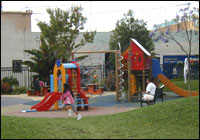
Sometimes, creating more greenspace is child’s play.
Since the agreement was signed, we have continued our work through the Figueroa Corridor Coalition for Economic Justice to bring an environmental perspective to this project. Our efforts have been somewhat hampered since Staples has not yet moved forward with its development plans. Although several projects were in the development stage in mid-2001, the downturn in the economy and decreased tourism has stalled Staples’ expansion plans.
In spite of this, we continue to help oversee the spending of the $1 million dedicated to park development. We are also working to incorporate a community-advisory element into the design of the construction and traffic-management plans. The coalition is encouraging the use of green building principles in the design and construction of the expansion buildings. Finally, we are preparing coalition members to more effectively participate in these efforts.
The benefits package negotiated around the Staples Center in L.A. is an important model for other cities, and therefore its implementation is critical not only to the local community but to others nationwide. We’re excited about replicating this kind of environmental success in other areas. I’m hoping our board members will see it the same way.
Friday, 9 May 2003
NEW YORK, N.Y.
Those of you who’ve been reading these entries all week know by now that I’m something of a non-traditional environmentalist. I was especially reminded of this at today’s board meeting, where I meet new members and employees who asked how I had come to work at Environmental Defense. Yet strange as it may seem, my path has led me to this work all my life. Really!
I was raised in Montebello, Calif., a small, ethnically diverse city east of East Los Angeles. Later, I would learn that I grew up in a crucible of environmental justice issues. I spent my childhood in low-income South Montebello (separated from the north by railroad tracks), where industrial plants operated next to homes and diesel trucks idled adjacent to my school playground. In high school, we joked about the sickly sweet smell from “the dump” in North Montebello — which later became a Superfund site. On Labor Day weekend, between my freshman and sophomore years in college, my family was evacuated in the middle of the night when a nearby plant released a dangerous amount of ammonia.
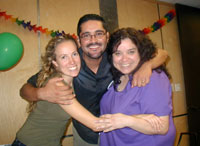
Lopez Mendoza (right), with Environmental Defense colleagues Luis Flores de Luna and Misty Sanford, celebrating the release of their “Walking to the Park” report last summer.
I did not know enough then to characterize these experiences as a pattern of environmental degradation. To be honest, through college I believed environmentalism was for white people, not for a Chicana like me. What did I care about endangered species when kids in my community were battling to finish high school? I was dedicated to becoming a teacher and helping low-income youth in the classroom.
I graduated from college in 1990, just as the first Gulf War was breaking out. Knowing little about the potential global impacts, I attended a teach-in in San Francisco in January of 1991. There, I met Ellie Goodwin of the Natural Resources Defense Council who discussed environmental problems affecting low-income and minority populations — and a light went on in my head. Ellie was the first person of color I had ever met who discussed the human impacts of urban environmental problems and gave the movement a name: environmental justice.
My career goals changed as I learned more. I subscribed to Race, Poverty and the Environment, then a fledging publication. I read the Church of Christ Hazardous Waste Sites Study, reports from the First People of Color Environmental Leadership Conference, and the resulting dialogue in the environmental community. I became convinced that ensuring that low-income communities had clean air and clean water was more important than becoming a teacher.
Because I had a liberal arts background unrelated to anything environmental, I had great difficulty breaking into the environmental field. I got my chance in 1992, when I was hired by the Environmental Careers Organization to be the first minority opportunities program director. I helped develop environmental internships at grassroots and other organizations for college minority students. I learned more about environmental organizations and the work that was emerging in the field of environmental justice. Almost everyone I met recommended that I go to law school to prepare myself to make an impact on environmental justice problems.
Following that advice, I went to law school at the University of California at Los Angeles, where I took specific courses to advance my interest in environmental justice and pursued an internship with social workers at a health clinic in the Pico-Union area of Los Angeles and another with economists at Rebuild L.A., an organization formed in response to the 1992 civil unrest in the city. I spent the summer of 1994 working with Luke Cole at the Center on Race, Poverty and the Environment, focusing on environmental problems on Native American lands.
My work in law school confirmed what I already knew: I wanted to pursue a career in community-based environmental law. Following three years of litigation experience, and after making healthy inroads into my law school debt, I joined Environmental Defense in April 2000, and haven’t looked back since.
Partly because of my family history, I have never questioned that my life-work would focus on social justice and equality. My uncle was a civil rights attorney in San Diego. A police brutality case he won in the late 1970s was appealed by the San Diego Police Department all the way to the United States Supreme Court, and he won at each stage. He founded the Lawyering for Social Change Program at Stanford Law School and now teaches at New York University Law School. Both of my parents are social workers. My mother, a psychiatric licensed social worker, has coordinated mental-health services at nonprofit organizations for immigrant families, abused mothers and children, and at-risk teens. My father, a social worker for the state of California, has facilitated hundreds of adoptions.
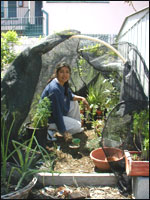
This is Marta, tending her part of the Francis Avenue Community Garden.
By following these examples, I was able to find my calling in environmental justice. I believe there are no rights more fundamental than the rights to clean water, clean air, and healthy food. Beyond those rights, I believe that families should not need to earn a certain amount of money for their children to have access to parks and green spaces, safe pedestrian walkways, and a quiet night’s sleep without diesel trucks rumbling past or airplanes screeching overhead. I plan to work to ensure that low-income and minority community members have a fair hearing before decision-makers — a luxury usually reserved for professional lobbyists.
Every day, I am excited by the work I do with community partners and residents. I recognize the challenges of working on environmental justice from within a “big green” group as opposed to a grassroots organization. But from reading this week about what we do, you can see we do this work as respectfully as we can. We’ve really tried to use the resources of Environmental Defense and apply environmental justice principles to work in coalition with diverse community-based organizations and residents to achieve the goals and objectives we have set together.
I plan to spend my life here in Los Angeles ensuring that environmental rights are protected for all people. Too often, poor people and people of color are doubly impacted by environmental degradation — both by a lack of access to the decision-making process, and by suffering the burden of environmental problems. I know my work is cut out for me in Los Angeles, home of urban sprawl, tense race relations, water wars, lack of green space, and vast disparities in income and wealth. But I also know we’ll succeed.
